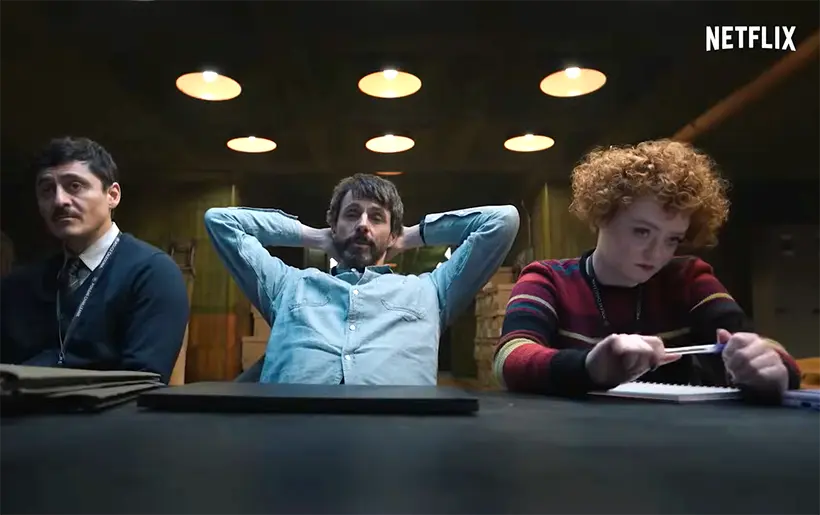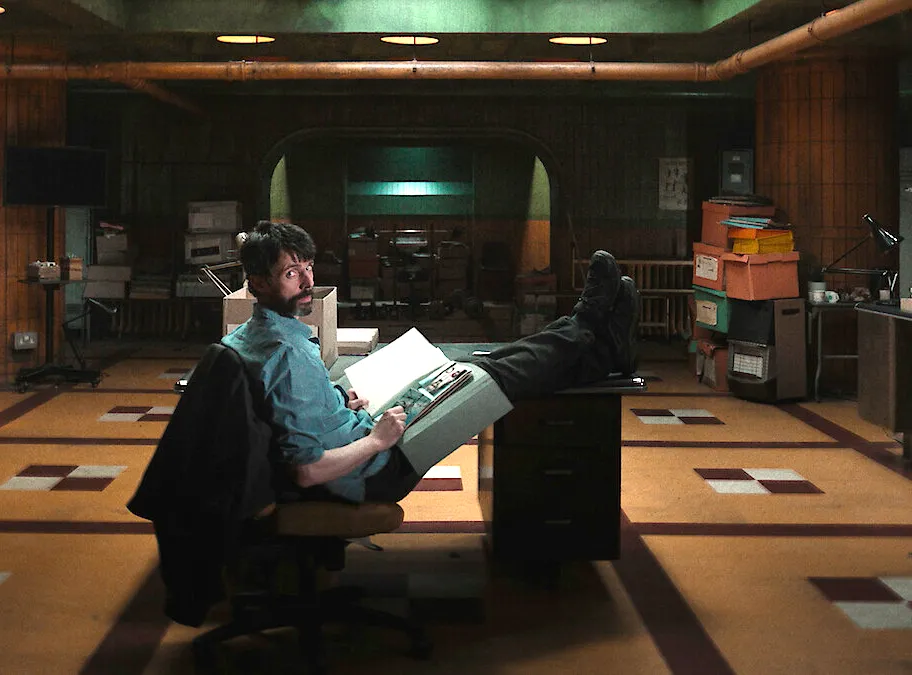Type and hit Enter to search
Experts in aesthetic surgery, dermatology, and beauty bring you the latest trends, research, and advice to help you make informed decisions about your appearance and health.
A web platform dedicated to aesthetic surgery, dermatology, and beauty, where expertise meets innovation, and your desires and needs become our mission. In a world where appearance and health go hand in hand, our platform leads the revolution, delivering the latest trends, research, and expert advice directly to you.
Our team consists of highly skilled professionals in the fields of aesthetic surgery and dermatology, committed to providing reliable information and guidance that will help you make informed choices about your appearance and well-being. We understand that every individual has unique needs and desires, which is why we approach each person with the utmost care and professionalism.
Powered by Aestetica Web Design © 2024
I Let Dept. Q Rewire My Brain About What Netflix Crime Drama Can Actually Achieve—Review
I thought I understood broken detectives until Dept. Q's Carl Morck shattered every assumption about damaged heroes. Scott Frank's Edinburgh-set masterpiece doesn't just adapt Jussi Adler-Olsen's novels—it weaponizes them into Netflix's most psychologically brutal crime drama. Matthew Goode transforms from period drama darling into a sarcasm-wielding force of nature, leading misfits through cases that expose corruption's true face. This isn't procedural comfort food; it's a nine-episode descent into institutional hell that makes you question everything.
I Gave Dept. Q Nine Hours of My Life and It Gave Me a New Obsession (Review)
A Cold Case Warms Up: How Netflix Rewrote Nordic Noir in a Scottish Key
What Scott Frank has done with Dept. Q isn’t translation—it’s transmutation. He doesn’t just borrow from Jussi Adler-Olsen’s prose; he breaks it down and rebuilds it molecule by molecule in a new context. And somehow, the result keeps the original’s emotional voltage while altering its entire cultural charge. This isn’t a cosmetic re-skinning—it’s a reengineering of tone, character, and national unease.
The novels, steeped in Danish gloom, present cold cases as existential puzzles and institutions as icebergs with rot beneath the surface. Frank preserves that philosophical backbone but restages it with a Scottish accent—literally and politically. The characters bristle differently here. The institutional indifference feels more resigned than hostile. The geography doesn’t just shift—it speaks a new thematic dialect. That’s what makes this Dept. Q adaptation a rarity: it moves countries without losing its center.
A Director with a Taste for Damage
Frank’s touch is unmistakable. Anyone who watched The Queen’s Gambit or Godless knows the drill: trauma wrapped in genre, with silence doing half the storytelling. In Scott Frank’s Dept. Q, that instinct for character over spectacle is weaponized. There’s no procedural gloss here—just people cracking under the weight of unfinished stories.
What makes this move particularly effective is Frank’s trust in stillness. He doesn’t rush to explain the source material by Jussi Adler-Olsen later adapted by Netflix, nor does he spoon-feed backstories. He assumes the audience can connect the dots, which, ironically, makes the emotional beats hit harder. And while the structure honors police drama conventions, it never bows to them. The result? A Netflix’s Dept. Q adaptation from Danish novels that feels both literary and visual, cerebral and cinematic—a rare dual allegiance that actually works.

The Ghost in the Basement: What Dept. Q Says About Institutions That Forget
Architecture as Allegory
The basement in Dept. Q isn’t just a location—it’s an indictment. It’s where the police force sends inconvenient officers and inconvenient truths to die of neglect. But it’s also where real work, and real accountability, stubbornly hang on. That double function is where the show’s Dept. Q symbolism does its best work: the place that was meant to silence justice becomes its accidental sanctuary.
What Frank does brilliantly is turn that setting into a psychological echo chamber. Claustrophobic framing. Fluorescent indifference. No windows, no sunlight, no optimism. It’s less a workspace and more a slow descent into institutional memory loss. And it’s not subtle—it shouldn’t be. The show knows that this basement is a metaphor with a capital “M,” and it leans in hard.
A Thriller That Thinks in Systems
This isn’t a show about one broken detective. It’s about a broken machine that keeps grinding forward. The cases are tragic, but the real horror is systemic. Incompetence isn’t the exception—it’s the software. And Netflix crime thriller themes like corruption, silence, and decay don’t emerge from plot twists. They ooze from the floor tiles.
But here’s the kicker: this critique never gets preachy. The writing trusts the audience to recognize how power avoids accountability—not through conspiracy, but through routine. That’s the brilliance of the institutional critique. It’s not shouted. It’s embedded. And the basement becomes its thesis—a symbol that keeps rotting even as it redeems. That’s why the Dept. Q basement symbolism in Netflix series lands so hard. It’s not just visual—it’s structural.
Misfits on a Mission: Why This Isn’t Just Another Crime Unit
When Backstory Isn’t Window Dressing
Forget what you know about “misfit teams.” Dept. Q doesn’t toss together a group of lovable weirdos and call it depth. It assembles damaged people with actual consequences and forces them to coexist. The Carl Morck character isn’t antisocial for effect—his trauma has hardened into contempt. He doesn’t solve crimes out of passion—he does it because everything else has failed.
Akram Salim isn’t the token foreign voice—he’s the one who sees the case’s blind spots because he’s lived through systems that collapse under their own weight. His empathy isn’t soft—it’s clinical. DC Rose Dickson isn’t a redemption arc waiting to happen. She’s a cautionary tale that kept going. Her fragility isn’t romanticized—it’s bureaucratically dismissed.

Function Over Chemistry
This team doesn’t bond. It operates. What connects them isn’t affection—it’s purpose. Their synergy is built on necessity, not sentiment. That’s what makes the Dept. Q cast analysis interesting. They’re not here to like each other. They’re here because they’re the only ones left who still give a damn.
The show resists tidy arcs. Nobody gets “better.” They just get sharper. Less naive. More useful. It’s a kind of professional intimacy—respect forged in crisis, not built in bonding retreats. That’s what gives the misfit team in Dept. Q its psychological depth, and why the Netflix series feels more like an autopsy of police dysfunction than a procedural with charm.
Case Files: Episode-by-Episode Breakdown
Episode 1–2: Trauma in the Frame
Dept. Q doesn’t start with a bang. It starts with a man who looks like he’s already survived one. Carl Morck arrives in the basement looking like he’s lost everything but his sarcasm. There’s no exposition dump, no flashy montage—just a cold, bureaucratic descent into exile. Frank’s direction doesn’t rush to explain. It lingers on silence, lets the claustrophobia set in, and forces us to sit in the discomfort alongside Morck.
Everything is heavy: the lighting, the pacing, the mood. Not slow in a lazy way—slow in a deliberate, bruising way. It’s less about establishing plot and more about grounding us in dread. We’re not watching a case unfold; we’re watching a psyche unravel. And the basement? It’s not just where Morck’s been dumped. It’s where the show hides its real thesis: justice begins where the institution stops pretending to care.
Opening the Merritt Lingard Case
The first case isn’t a scream for help—it’s a whisper from a file no one wants to touch. Merritt Lingard was a prosecutor who disappeared years ago. Officially, it’s a dead case. Unofficially, the details never added up. She got too close to something, and then she was gone. That’s not a mystery—that’s a warning.
The beauty here is in the detail. Notes scribbled in margins. A recorded interview with a gap that shouldn’t be there. It’s procedural, but with a noir heartbeat. As Morck starts pulling at the thread, the show’s rhythm shifts. You can feel the system flinch. And you understand: this isn’t about one missing woman. It’s about what happens when someone tries to prosecute the powerful—and loses.

Episode 3–6: Cold Clues and Hot Leads
The Slow Excavation of a Buried Truth
The investigation crawls forward, not because the team is incompetent, but because the world around them is resistant to being known. Leads evaporate. Records are incomplete or corrupted. Witnesses lie politely. This is where Dept. Q excels—it makes obstruction feel existential.
Morck doesn’t rage. He obsesses. Carl Morck sifts through silence like it owes him answers. His team becomes his instrument: Akram Salim translates both language and trauma, while DC Rose Dickson throws herself into the work with the desperation of someone who can’t afford to break again. The deeper they dig, the more it becomes clear—Merritt Lingard didn’t just vanish. She was erased.
Team Dynamics Under Pressure
These episodes stretch the team’s limits. Morck is still a closed door, but something shifts. He listens. He pauses. He lets silence hang where he used to fill it with dismissal. Salim, usually composed, starts to lose patience with institutional cowardice. And Rose? Rose stops waiting for permission. She pushes forward with something that looks a lot like defiance.
There’s no big speech, no sudden bonding moment. Just three people slowly aligning, not because they want to, but because the case demands it. The tension isn’t resolved—it’s redirected. Into the investigation. Into each other. Into a shared sense that the truth matters, even when no one else agrees.
These aren’t episodes that dazzle—they grind. They strip the characters down. They show the emotional cost of persistence. And they set up the final act with a quiet intensity that hits harder than any plot twist ever could.

Episode 7–9: Everything Rises in the Basement
Uncovering What Was Meant to Stay Buried
By the final stretch, Dept. Q stops hinting and starts cutting deep. The tension that’s been simmering since episode one finally breaks surface. Merritt Lingard isn’t just a missing person—she’s the match that threatened to ignite the entire legal system. And someone made sure she disappeared before that could happen.
What elevates this reveal isn’t the twist itself—it’s how quiet it is. There’s no courtroom showdown, no confession under pressure. Just evidence that was always there, hidden in plain sight. The system didn’t fail her by accident. It did exactly what it was designed to do: protect itself. That’s the show’s most brutal revelation. And it lands not with a bang, but with the kind of silence that follows a truth everyone already suspected.
Carl Morck doesn’t get closure. He gets clarity. He finally sees the full pattern—not just of this case, but of how the institution swallows people like Merritt. And how close he came to being next.
The Team That Became the Work
By the final episode, the team dynamic has hardened into something sharper than friendship: purpose. DC Rose Dickson isn’t the anxious junior anymore—she’s the one pushing the case over the finish line. Akram Salim has stopped translating between cultures and started interrogating power directly. And Morck? He’s still gruff, still insufferable—but his instincts are sharper, his defenses thinner.
There’s no triumph here. Just grim resolution. The case is solved, but nothing is clean. Careers are threatened. Documents go missing. Whispers replace conclusions. But for the first time, the basement isn’t just a punishment. It’s a proving ground. A place where people who were written off forced the truth into daylight.
That’s why this ending hits harder than most procedural finales. It doesn’t wrap things up—it exposes them. And in doing so, it finally justifies why Dept. Q, buried at the bottom of the building, is the only part of the institution still worth watching.
Who Killed Merritt Lingard (and Why It Matters)
The Prosecutor Who Knew Too Much
Merritt Lingard isn’t just a plot device or a missing person case with emotional resonance. She’s a system disruptor—a prosecutor who looked too long and too hard at the machinery around her and found rot in every gear. Her disappearance isn’t random. It’s an act of containment.
Dept. Q never romanticizes her. It doesn’t need to. It lets the Merritt Lingard character stand on the strength of her convictions and the fallout they cause. Through found documents, overheard conversations, and those small, damning details that never quite made it into the official file, we learn she wasn’t chasing personal glory. She was chasing accountability. And that’s what made her dangerous.
What makes her story cut deeper is the realism in its arc. There’s no grand conspiracy board, no Bond-villain antagonist. The threat she uncovers is institutional, procedural, and depressingly mundane. The moment she became a liability, she vanished. That’s not just a twist in the Dept. Q plot mystery—it’s a comment on how power deletes what it doesn’t want to explain. The Netflix missing prosecutor narrative is less about who did it and more about how many didn’t stop it.
Every Clue Is Political: The Real Cost of Justice
Dept. Q isn’t just a crime series. It’s a political act. Every clue that surfaces isn’t just narrative propulsion—it’s a referendum on institutional cowardice. What begins as a procedural turns into a slow, precise indictment of how justice systems enable their own dysfunction.
The Dept. Q themes aren’t coded in monologues or exposition. They’re embedded in the friction between what’s uncovered and what remains ignored. This is where the show aligns itself with the great political crime dramas of the past: the idea that solving the case often means implicating the institution that assigned it.
This is especially clear in the Merritt arc. Her work exposes not just individual guilt but collective complicity. Witnesses hide. Colleagues hedge. Superiors bury. The deeper the team digs, the more they find not just obstruction, but orchestration. That’s why the Netflix justice corruption thread never feels tacked on—it’s the bedrock of the story. And it’s what elevates the narrative from mystery to autopsy.
Broken Men and Basements: The Character Arcs
Carl Morck: Guilt in a Trench Coat
Carl Morck doesn’t walk into Dept. Q so much as collapse into it—all trench coat, haunted eyes, and the energy of someone who’s run out of things to lose. From the first frame, it’s clear he’s not the brooding antihero type. He’s something grimmer: a man hollowed out by the job and still expected to keep going.
The Carl Morck character arc isn’t about healing. It’s about adapting—finding a functional version of yourself inside the wreckage. What makes this arc work is how little sentimentality it allows. No heart-to-hearts, no teary breakthroughs. Just a man inching toward usefulness, mostly out of spite.
Matthew Goode plays him like he’s allergic to emotional clarity. There’s a restraint in his body language, a clipped rhythm to his delivery, that reads as someone constantly fighting his own instincts. It’s not charming, but it’s brutally honest—and that’s rare in Netflix detective roles, which often favor melodrama over mechanics. This performance earns its place in the genre because it knows when to stay quiet.
By the end, Morck isn’t redeemed—he’s recalibrated. Still difficult, still dry, but now a piece of the machine he tried to avoid. That’s what makes the Carl Morck psychological journey in Netflix’s Dept. Q so satisfying: it doesn’t fix him. It just finds a way to make him matter.
Rachel Irving: The Therapist With Teeth
Rachel Irving could’ve been a placeholder—just another TV therapist spouting generic wisdom and furrowed brows. Instead, she shows up with spine, bite, and a refusal to let Morck disappear into his own detachment. Kelly Macdonald gives the character a center of gravity that isn’t just emotional—it’s strategic.
The Rachel Irving character analysis in Dept. Q Netflix lands because she doesn’t just listen; she interrogates. Her scenes are power struggles disguised as sessions, and her rapport with Morck feels earned, not engineered. There’s chemistry, yes, but it’s the kind built through friction, not flirtation.
Macdonald, who’s done subtle, simmering work in past Kelly Macdonald Netflix roles, brings that same quiet control here. She never oversells. She just waits, lets silences stretch, and then punctures them with surgical precision. It’s what makes Rachel Irving more than just support—she’s the story’s moral barometer.
In a show that trades heavily in brokenness, she’s not the fixer. She’s the reminder that fixing is a choice, not a given. That edge is what defines Rachel Irving’s role in Dept. Q and anchors the show’s emotional honesty amid the procedural grit.
Technical Brilliance: What Makes Dept. Q Pop
Scotland, Seen in Noir
Edinburgh doesn’t just host Dept. Q—it haunts it. This isn’t the postcard version of the city. It’s all wet stone, narrow alleys, and skies that feel like they’re thinking dark thoughts. The show doesn’t use Edinburgh as background; it turns it into texture. Every street corner is a pressure point. Every foggy skyline is a warning.
What sets it apart is restraint. The camera doesn’t gawk—it stalks. No sweeping drone shots, no overlit glamour. Just grounded, glacial compositions that let the landscape breathe menace. The Dept. Q filming locations are more than settings—they’re psychological traps. And that’s exactly the point.
This isn’t just another Edinburgh crime series dressing itself in gloom. It’s noir with a pulse, using architecture to amplify dread. The result? A kind of visual claustrophobia that quietly throttles the viewer scene by scene.
Cinematography With Intent
What makes Netflix noir visuals sing here is how carefully they’re weaponized. Shadows aren’t decorative—they’re accusatory. Lighting schemes isolate rather than illuminate. The palette doesn’t flirt with monochrome; it commits to it. And every frame seems to ask: Who’s hiding? And who’s already been erased?
That’s what makes the cinematography in Dept. Q, set in Edinburgh, so sharp—there’s no visual fat. Every detail earns its keep. The aesthetic doesn’t just look good. It looks like guilt.
Direction That Hurts So Good
Frank’s Fingerprints
If you’ve seen The Queen’s Gambit, you know Scott Frank doesn’t direct scenes. He composes pressure. In Dept. Q, that tension is dialed tighter. Gone is the chessboard precision—in comes the bureaucratic labyrinth. And somehow, it hits even harder.
Scott Frank’s Netflix signature is all over this: emotional understatement, narrative patience, and a refusal to coddle. He doesn’t chase spectacle. He corners it. What makes this work is how his instincts have evolved—from stylized grit to procedural suffocation.
Style Meets Substance
Frank’s direction thrives on friction. The cuts are abrupt, the pacing glacial, the tone claustrophobic. And yet, it never feels static. That’s the paradox: it’s slow, but it stings. Every silence is a slap. Every long take is a threat.
This isn’t just stylish crime drama—it’s surgical tension. The Dept. Q direction doesn’t just build mood. It crushes with it. That’s what separates this show from its genre cousins. Where others gesture at darkness, Dept. Q weaponizes it.
Scott Frank’s directing style in the Netflix adaptation of Dept. Q doesn’t chase prestige aesthetics. It earns them by strangling comfort and forcing the audience to sit with unresolved tension. And that, more than anything, is what makes it unforgettable.
SOURCES:
Meet the Star-Studded Cast of Netflix’s Dept. Q: Matthew Goode, Kelly Macdonald, Mark Bonnar & More, Dept. Q: Cast, Release Date, Photos, Plot of New Matthew Goode Netflix Series, Dept. Q TV Series 2025 News, Screen Queen TV Reviews: Dept. Q, The Quilters, And Just Like That and Pee-wee As Himself, Dept. Q TV Series 2025 IMDb, A must-watch for Slow Horses fans: meet Netflix’s new Scandi crime drama.



